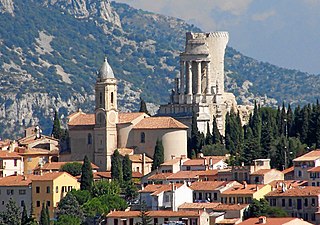The Calucones were a Gallic or Rhaetian tribe dwelling around present-day Chur during the Roman period.

The Tropaeum Alpium, is a Roman trophy (tropaeum) celebrating the emperor Augustus's decisive victory over the tribes who populated the Alps. The monument's ruins are in La Turbie (France), a few kilometers from the Principality of Monaco.

The Camuni or Camunni were an ancient population located in Val Camonica during the Iron Age ; the Latin name Camunni was attributed to them by the authors of the 1st century. They are also called ancient Camuni, to distinguish them from the current inhabitants of the valley. The Camunni were among the greatest producers of rock art in Europe; their name is linked to the famous rock engravings of Valcamonica.
The Nantuates or Nantuatae were a Gallic tribe dwelling around present-day Massongex, in the modern Canton of Valais (Switzerland) and adjacent areas of France, during the Iron Age and the Roman period.

The Vindelici were a Gallic people dwelling around present-day Augsburg (Bavaria) during the Iron Age and the Roman period.
The Uberi were a Celtic tribe dwelling near the source of the Rhône river, in the modern-day Canton of Valais (Switzerland), during the Iron Age and the Roman period.
The Acitavones were a small Gallic tribe dwelling in the Alps during the Iron Age.
The Venostes were a Celtic or Rhaetian tribe dwelling in the present-day Vinschgau Valley during the Iron Age.
The Eguiturii or Eguituri were a Celto-Ligurian tribe dwelling in the Alpes Maritimae during the Iron Age.
The Ambisontes were a Gallic tribe dwelling in the upper Salzach valley during the Roman period.
The Ucennii,Ucenni or Iconii were a Gallic tribe dwelling in the Romanche valley, in the Alps, during the Iron Age.
The Vergunni were a Gallic tribe dwelling in the valley of the Riou, near the Verdon river, during the Iron Age.
The Sogionti or Sogiontii were a Gallic tribe dwelling around present-day Sisteron during the Iron Age.
The Rucinates or Rucantii were a Gallic tribe dwelling in near the confluence of the Isar and Danube rivers during the Roman period.
The Gallitae were a Gallic tribe dwelling in the upper valley of the Bléone river (Alpes-de-Haute-Provence) during the Iron Age.
The Brigianii were a Gallic tribe dwelling around present-day Briançon during the Iron Age and the Roman period.
The Catenates or Cattenates were a Gallic tribe dwelling between the Isar and Inn rivers during the Iron Age.
The Licates were a Gallic tribe dwelling in the upper valley of the Lech river during the Iron Age and the Roman period.
The Brixentes or Brixenetes were a Celtic or Rhaetian tribe living in the Alps during the Iron Age and the Roman era.
The Nemaloni were a Gallic tribe dwelling in the middle valley of Durance river during the Iron Age.



